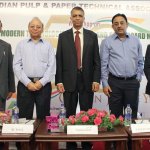 Paper Recycling Conference India, a business event related to paper and paper recycling industry in the Indian subcontinent, was organized on January 29-30, 2014 at Hotel Taj Palace, Delhi. The two day event was produced by the US based Recycling Today Media Group in the partnerships with the Indian Paper Manufacturers Association, Indian Pulp & Paper Technical Association, Indian Agro & Recycled Paper Mills Association and the Gujarat Paper Mills Association. The conference was envisaged as a facilitating platform for those who wish to tap the growing potentials of Indian paper industry as the trend indicates that firms from many North American and European countries are looking to establish and grow business here in India.
Paper Recycling Conference India, a business event related to paper and paper recycling industry in the Indian subcontinent, was organized on January 29-30, 2014 at Hotel Taj Palace, Delhi. The two day event was produced by the US based Recycling Today Media Group in the partnerships with the Indian Paper Manufacturers Association, Indian Pulp & Paper Technical Association, Indian Agro & Recycled Paper Mills Association and the Gujarat Paper Mills Association. The conference was envisaged as a facilitating platform for those who wish to tap the growing potentials of Indian paper industry as the trend indicates that firms from many North American and European countries are looking to establish and grow business here in India.
Indian Paper Industry in Coming Decade
The two day of the conference saw many segments wherein each segment dealt one pertinent issue in elaborate manner coupled with Q&A round to quench the query from audience. The segments were deftly handled by the expert panel concerning the area of discussion. The first day, in its opening keynote session, witnessed the executives representing recycled paper mills in India discuss how they believe the industry will evolve during the next decade. The panel included Mr. Jogarao Bhamidipati, ITC Limited; Mr. P. S. Patwari, Emami Paper Mills Ltd.; Mr. Arun Bijur, SPB Projects and Consultancy; Mr. Rahul Khanna, Khanna Paper Mills Ltd.
The keynote session was filled with views, insights and forecasts on recycling industry as a whole wherein recovered fiber availability and consumption formed the core of discussion. All panelists agreed on waste paper as the key raw material for Indian paper industry. The weak rate of waste paper recovery and predominant position of imported waste paper also reappeared in the discussion many times. The strengthening of collection mechanism and methods like source segregation were advocated by panelists during debate.
Recycling: Building Nation, Conserving Nature
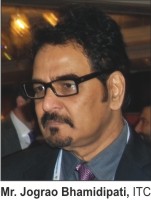 Speaking on the viability of recycling waste paper, Mr. Jograo Bhamidipati, ITC threw some illuminating experiences out of his involvement with ITC’s WOW (Wealth out of Waste). He said, “As everybody know that IT industry made inroads 30-35 years back, and in last ten years everybody said that there will be paperless offices. It’s not true. Paper consumption is growing across the globe and India is no exception. In fact, paper consumption is growing at much faster rate in India with 8 percent CAGR across the segments. And, waste paper as raw material is very essential for Indian paper industry. Out of total 800 mills in India, nearly 600 mills depend on recycled fiber for raw material. Therefore, we need to push the initiative like WOW.”
Speaking on the viability of recycling waste paper, Mr. Jograo Bhamidipati, ITC threw some illuminating experiences out of his involvement with ITC’s WOW (Wealth out of Waste). He said, “As everybody know that IT industry made inroads 30-35 years back, and in last ten years everybody said that there will be paperless offices. It’s not true. Paper consumption is growing across the globe and India is no exception. In fact, paper consumption is growing at much faster rate in India with 8 percent CAGR across the segments. And, waste paper as raw material is very essential for Indian paper industry. Out of total 800 mills in India, nearly 600 mills depend on recycled fiber for raw material. Therefore, we need to push the initiative like WOW.”
On the recovery scenario, Mr. Bhamidipati had much to share as the WOW initiative fundamentally targets to increase the rate of recovery. He asserted, “Today, at the level of 12.7 million tonnes of paper being consumed, only 4 million tonnes are being recovered and out of this only 3.7 million tones are coming back to industry for recycling. Nearly 8 million tonnes of paper, what we use, ends up in the garbage bins and finally to landfills. The initiative WOW is actually looking at recovering this 8 million tonnes.”
Mr. Bhamidipati also underlined the significance of local recovery of waste paper in cutting the import bills and doing away with the unwanted waste imported from other countries. “Nearly 4.2 million tonnes of waste paper are getting imported at the cost of USD 2 billion. And, among the grades which are imported, some are not quite eco-friendly where we as a company face a lot of problems,” he said.
Stressing the need to fortify the collection mechanism, Mr. Bhamidipati questions the discipline and habits of citizenry which is coming in the way of effective implementation of waste collections initiatives. They need to be made aware of the repercussions of inflating garbage landmasses in coming times as the population is fast increasing and waste generation matching the population growth will exhibit its hazardous face. Mr. Bhamidipati believes that striking an emotional chord with public will go a long way in making such programs successful. He also emphasizes the need to identify the most viable beneficiaries of such initiatives which will participate in collection programs out of monetary benefits.
“8 million tonnes is a big target. We are moving towards that but we are way behind. Today, we are collecting 4000 tonnes in some cities like Bangalore, Kochi, Coimbatore, and Hyderabad. It’s moving but not in the way we wanted. It’s all the question of discipline and habits of people,” said Mr. Bhamidipati.
He added, “The people just nod their head if you tell them to source segregate the recyclables and keep aside which can become raw material for industries such as glass, paper, plastic, etc. We also talked about dwindling natural resources and how India is going to have serious problem as we move forward. With increasing population, the quantum of garbage is also increasing. The handling of such garbage will prove to be a huge problem with the limited landmass available. The quantum of garbage generated by an individual everyday is around 800 gm and we need 47 acres of land to landfill the garbage we generate every day. Imagine what will happen to India! Next to Tajmahal, there would be a huge dump of garbage! And, same thing will happen all across the country.
“We talked everything with people, but it was not happening. So we started moving towards the best beneficiaries of such programs who are the rag pickers and waste collectors. We focused on how to make them green ambassadors and make the program successful. This is what we started doing in last one year which has now moved to be the part corporate social responsibility now.
“Going forward, as we are going to touch 25-30 tonnes of consumption by 2025, the quantum of waste paper will also increase accordingly. By 2025, 17 million tonnes of recycled fiber will be required by the paper industry. We are at the level of 3.7 million tonnes now; the sky is the limit to go to the maximum.”
With No Wood, Recycling is the way Ahead
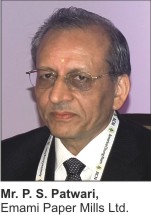 Mr. P. S. Patwari, Emami Paper Mills Ltd., also affirmed the ascending status of recovered paper as main source of raw material for the Indian paper industry. He said, “In our country today, we are producing 50 percent of paper and paperboard from recovered paper. This proportion is going to increase in coming times. In next ten years, by 2025, the paper consumption will be doubled to 25-30 million tonnes from present 13-14 million tonnes with 7-8 percent growth every year. Because the wood is not there and agro residues have its limitations, only path for future growth is recycling.”
Mr. P. S. Patwari, Emami Paper Mills Ltd., also affirmed the ascending status of recovered paper as main source of raw material for the Indian paper industry. He said, “In our country today, we are producing 50 percent of paper and paperboard from recovered paper. This proportion is going to increase in coming times. In next ten years, by 2025, the paper consumption will be doubled to 25-30 million tonnes from present 13-14 million tonnes with 7-8 percent growth every year. Because the wood is not there and agro residues have its limitations, only path for future growth is recycling.”
He added, “Recycling in last 5years, to the utter surprise of everyone, has been growing in our country. Thanks to rupees depreciation which discouraged the imports and collections of waste paper increased due to increased realization.
“From a figure of 27 percent five years back to 33 percent today, the recovery has really been moving forward. In the next ten years, when our paper consumption would be in the range of 25-30 million tonnes and 50 percent paper coming from recycling, our recovered paper requirement would be around 20 million tonnes. If only this rate continues i.e. 33 percent, we would recover at least 10 millions. And the same amount of input would be fed through imports. So there is a big scope for recycling. The main growth may be seen in the packaging”
Mr. Patwari expressed his concerns over the cost of imported waste paper and requested all the international suppliers to devise some formula so that India comes at par with China and other such countries who are also dependent on recovered paper for their raw material. He said, “Main concern is cost. The recovered paper being supplied to China and other countries is 30-35 percent cheaper than the one supplied to India. Issues related to logistics are also a concern. So, I request to all international suppliers to work out some formula for that treating us at par with other countries.”
Many of the Indian newsprint producers and mills are facing crisis and difficult times. When asked the question that how his mill has been able to steer through these difficult times in terms of raw material and marketing of finished products, Mr. Patwari said, “Paper itself is a difficult commodity particularly newsprint which is very difficult to operate in the conditions prevailing because more than 60 percent of our requirements is met through imports. Still, we have managed to match the quality and price as per the expectations of our customers by way of increasing the productivity and cutting the cost. Newsprint is a zero tolerance commodity where not even 0.1 percent deviation in the quality is allowed. Even with these stringent parameters, we have been able to perform. That is why, in my initials remarks, I requested to my friends from abroad that they should provide us with the recovered paper having matching prices with our friends like China.”
Recycling Taking Baby Steps
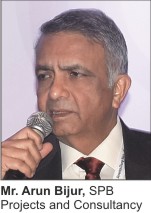 Mr. Arun Bijur, SPB Projects and Consultancy, sounded positive when he said that recycling will be something that will be developing with greater force in years to come. “One of the negative factors impacting the growth of paper industry is the lack of raw material and the uncertainties that goes with it. We do generate a lot of material that can be gainfully recycled. I think what we need, apart from discipline, is the Government’s intervention with some form of enabling provisions that will solve two major issues-one is raw material, other is much better way of handling the garbage,” he added.
Mr. Arun Bijur, SPB Projects and Consultancy, sounded positive when he said that recycling will be something that will be developing with greater force in years to come. “One of the negative factors impacting the growth of paper industry is the lack of raw material and the uncertainties that goes with it. We do generate a lot of material that can be gainfully recycled. I think what we need, apart from discipline, is the Government’s intervention with some form of enabling provisions that will solve two major issues-one is raw material, other is much better way of handling the garbage,” he added.
On whether Mr. Bijur sees some new paper mills likely to come up in India and where he finds the industry heading in terms of development, he said, “In brown grades, the recycling has been business for quite some time, and in more recent years, it’s paper board where I would not call it strictly recycling as far as paper industry is concerned; it’s more of a filler. The quality expectations are not as stringent as it is for recycling to produce newsprint or other fine papers. So, I think when it comes to fine paper, the growth will be still largely dependent upon virgin based fiber.”
He added, “But, the movement has already started where recycled waste would start some amount of virgin fiber. There is a market perception that paper with recycled content is inferior. However, I suppose with very few options to secure the raw material in virgin pulp production, the large mills, whose growth steps are also very large, cannot contemplate capacity expansion on virgin pulp side.”
In this manner, Mr. Bijur forks out a way for recycling to grow as virgin pulp scarcity is quite conspicuous. He said, “There is one mill in South India which has commissioned a state-of-the-art deinking plant which targets to produce pulp comparable virgin pulp mills. In the near term, we would be witnessing some targeted furnish mix changes that would permit 25-30 percent recycled pulp in white grades. The future of recycling, I think, still would be in terms of baby steps but the scope is immense as the economy is growing and with that the consumption of paper.”
Recycling: A Necessity, Not Choice
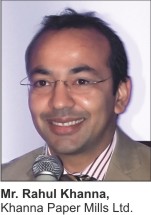 Mr. Rahul Khanna, Khanna Paper Mills Ltd., said that recycling should be considered as a necessity today, not a choice. “We don’t have wood, nor do we have enough agro residues which makes us tend naturally towards recycling and as such we must contribute to the growth of recycling industry in our country,” he said.
Mr. Rahul Khanna, Khanna Paper Mills Ltd., said that recycling should be considered as a necessity today, not a choice. “We don’t have wood, nor do we have enough agro residues which makes us tend naturally towards recycling and as such we must contribute to the growth of recycling industry in our country,” he said.
Commenting on other issues, Mr. Khanna counted cost and infrastructure as two serious concerns. “Getting recovered paper from south India to north India is costlier than the paper coming from the US,” he said.
Mr. Khanna also highlighted the fact that India today is part of global economy and as such it cannot remain aloof from the events of taking place in one part of the world. He urged the Indian paper industry to develop a global perspective and thought process.
Khanna Paper Mills has registered substantial growth in recent years and has become one of the premiere mills in the country. How the mill has managed to sustain and grow when the conditions are not so favouarable, Mr Khanan has an answers. “The paper industry is the one where either you grow, or you go down. You have to decide which way you want to go. Our company decided to grow rather going down. Costs do drive a lot of things today, so we always feel the necessity to curb it. But, cost of waste paper cannot be reduced below a certain point and international suppliers are charging you what they have to charge as per the prevailing market rate. Hence, it all comes to your own manufacturing process where you can do something to reduce the cost. And, that can be done by increasing the production where the introduction of new technology may help greatly.
“In India, the man power cost has increased to the extent that it’s now matching to wages in the US and the European countries. With these limitations, small mill owner can’t invest in technology. That’s another snag.
“We started our growth curve with packaging, then moved to wood-free and finally we are doing newsprint. We have been able to do it all because of increased the productivity by virtue of cost cutting and technology. Moreover, if the paper industry has to grow, consolidation has to be there as there is too much fragmentation in our industry.”
Factors Impacting Growth
When asked to enumerate two largest factors impacting the growth of paper manufacturing business in India, the panelists retorted almost in unison about the dearth of raw material as the most fundamental factor impeding the growth. However, the issues like outdated technology, image of the industry, enabling legislations, and infrastructure also appeared invariably in all response.
Mr. Patwari said, “There are many factors. One is the raw material availability. The land for plantation is not available. There is plenty of waste land, but the policy of the Government is not permitting the industry to have plantations there. Industry has been trying for long, but there is no result so far. The government’s forest is also not progressing, and sourcing wood from these forests is quite difficult
“There are limitations with recovered paper. From collection point of view, though the paper is being collected, it’s going to different usages. For recycling, only 30-35 percent is reaching to industry. Balance is going to so many other usages. Agro-residue is also going to various usages as fodder and fuel. That’s too a big constraint.
“The Government policies so far have not been favorable or conducive for the growth of the paper industry. For waste land utilization, there must be some policy for plantation on the degraded forest land.”
He cited the absence of safeguards on newsprint imports as a big factor. “For newsprint imports, there is no safeguard. It’s a dumping yard. The Government is not providing any safeguard to the local industry which is available to the industries in all countries across the globe. The international suppliers are selling newsprint at USD 700 in their country; the same newsprint is sold in our country for USD 500 after spending USD 50-60 on freight. That’s dumping. Only the Government can do something about it.
“Similarly, the Free Trade Agreements (FTAs) with ASEAN nations are hampering the growth of indigenous paper business. ASEAN nations have plenty of wood available, wood cost for mills operating in these countries is one quarter less than the cost we pay for wood. And, the paper out of these mills is freely available in our country at zero duty. Before signing any such FTA, the Government must consult and discuss with industry about what will happen to the big investments made.”
Mr. Patwari also raised a question on the image of the paper industry. He said, “The image of our industry is not good. All industry people should be held responsible for this. Among 800 mills operating, there is no coordination. Without coordinated efforts, we can’t have the image building exercise. It’s a big budget exercise wherein everybody has to participate. Because of the bad image, we are not drawing the new talent desperately needed by our industry.”
Mr. Rahul Khanna emphasized the need to adhere to environmental regulations. He said, “750 out of 800 mills are not following healthy environmental practices which will impact hugely in times to come.”
He added, “The cost of capital is high. Paper being a capital intensive industry, the capital needs to be infused on continuous basis. Technology does not come cheap. Because of cost of capital, the industry is not up-to-date in terms of technology.
He also expressed his concern over the lack of talent. He remarked, “For last fifteen years, we have been hearing the same name in the industry. Where are the new faces?”
Looking at the brighter side, Mr. Arun Bijur said, “Not all is gloomy. Indian economy is growing and India has the fastest growing literate population. The paper as a commodity will hugely benefit from such growth.
“The paper industry is resilient enough. As it finds the market, viability of projects, we will find the raw material. We will also find ways to overcome the over-regulations we have been talking about. Right now, the environmental regulations are perceived more in terms of retarding growth. In fact, regulations themselves are not severe in themselves; it’s just time consuming. Also, the way these regulations are enforced is not right. Pollution standards are devised in a manner that pollution is monitored by how much you produce not by how much you pollute. This should change.”
Mr. Bijur added, “I am also associated at some policy making level and I think there is a change on the cards. The picture is not as dark and gloomy as one may extrapolate from the position the industry is in right now.”
Mr. Jograo Bhamidipati raised questions on the status of enabling policies of the government, besides citing the lack of infrastructure as a major issue faced by the industry. He said, “We have practical experience at ITC. It has been six years now, an amount of Rs. 5000 crore is kept aside by the chairman to put up a mega project in Andhra Pradesh. We are still struggling. We have money, will and intention, still it’s not happening. Therefore, enabling policies are very, very essential if industry has to grow. I hope with the present Government, the ideas they are talking about, things should change.
“Again, I have a practical experience to share. A year and a half back, we started importing logs and chips into the country. The cost of logs and chips at port level is if X, the quantum of money we spent in handling and transporting was more than X. So, that’s the kind of infrastructure problem we are facing.”
Recovered Paper: The Pricing Trends
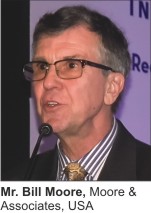 At the first day only, Mr. Bill Moore, Moore & Associates, USA, gave a convincing presentation of pricing trends within the EU and North America along with factors that are affecting price forecasts. According to Mr. Moor’s analysis, for the last several decades, recycled fiber has a distinct cost advantage over virgin fiber for the production of newsprint, away from home tissue products, containerboard, and recycled paperboard. But not for printing / writing grades and high end packaging.
At the first day only, Mr. Bill Moore, Moore & Associates, USA, gave a convincing presentation of pricing trends within the EU and North America along with factors that are affecting price forecasts. According to Mr. Moor’s analysis, for the last several decades, recycled fiber has a distinct cost advantage over virgin fiber for the production of newsprint, away from home tissue products, containerboard, and recycled paperboard. But not for printing / writing grades and high end packaging.
Mr. Moore, however, warned that cost advantage dynamics may change due to increasing paper costs over the next ten years. He said, “This will mainly happen because of higher commodity cycle costs. Moreover, lower quality, shorter fibers and non-fiber contaminants may lower the yields. Not a short term factor, but ultimately this sets the outer bounds of recovered paper pricing.”
Shifting his focus on macro OCC demand issues, Mr. Moore said, “OCC is the largest volume grade about 50 percent of the recovered paper market. OCC has major impact on global prices for all recovered paper grades. Much of Asia, the Middle East and especially China’s paperboard industry depends on OCC. India uses all grades of OCC, with some emphasis on the high quality side for double sorted OCC and DLK, but on the low side imports some waxed OCC. However, new recycled fiber board mill projects in China, the US, and other parts of the world in 2015 will put upward pressure on OCC prices.”
Elaborating more on macro OCC supply issues, Mr. Moore said that OCC recovery in the developed regions of the world is very high, really at the maximum level in many parts of Europe and headed that way in the US. He was of the opinion that China and India, as well as the rest of the developing regins of the world, will continue to increase the OCC recovery.
On the OCC future demand trends, Mr. Moore said that China’s huge appetite for OCC drives the world price, when their packaging board mill operating rates rise, so will global OCC prices. He added, “Over the next five plus years, we may see unbleached kraft pulp be competitive with OCC especially at the top of the pricing cycles in China, but supply of the grade is limited and expensive.
“An even more likely scenario is the use of additional virgin kraft pulp in pace of some OCC in the US. New OCC based containerboard mill projects are most likely to come up in Asia, the Middle East, Europe, and North America.
The third part of the first day was centered at recovered paper supply in Europe and the Middle East wherein the evolution of paper recycling in Europe and the Middle East was discussed in detail through presentations. The debate also underlined how the changes underway are affecting the ability of these regions to supply to the Indian subcontinent. The discussion panel included Mr. Shiraz Hamirani, Paper Chase International, UAE; Mr. Marc Ehrlich, Vipa Lausanne SA, Switzerland; Mr. Pankaj Chowdhary, Reliance Fibres Limited., UK; Mr. Ranjit Baxi, J&H Sales International, UK; Mr. Saifee Jani, Paper Link International FZCO, UAE.
The first day’s final segment saw the focus on regional supply issues. A diverse panel of paper mill executives from the Indian subcontinent discussed the recovered fiber situation in the region. The discussion touched on a wide range of topics, including the challenges and opportunities for increasing recovered fiber collection levels, quality demands by consumers and the outlook for the paper and recovered fiber market throughout the Indian subcontinent. Mr. Vijay Gupta, DaiEi Papers SE Pvt. Ltd.; Singapore; Mr. Jay Kedia, Cellpap Mercantile Private Limited, India; Mr. Manish Patel, The South India Paper Mills Ltd., India participated in the debate.



